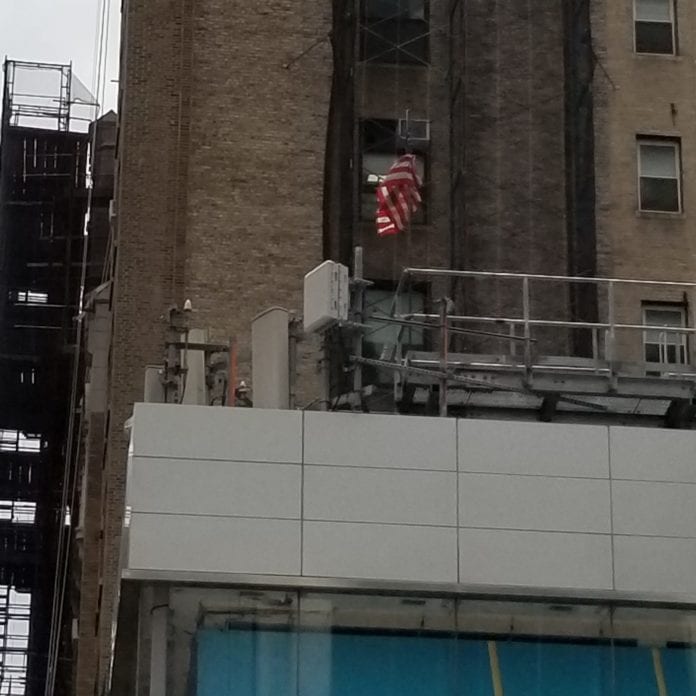NEW YORK–Above an enormous blue billboard featuring a woman on a swing, the drab, briefcase-sized box wouldn’t catch your eye unless you were hunting for it. But I was. I pulled up Ookla Speedtest on the shiny, new 5G device in my hand and hit “go.”
This was the nearest 5G site to the Sprint office where company executives had spent much of the morning discussing the work that went into rolling out the carrier’s 5G deployment: now in nine markets, covering around 11 million people and about 2,100 square miles, with NYC one of the new additions this week.
Nokia’s Ricky Corker, president of customer operations for the Americas for Nokia, had reminisced about the early prototypes of the equipment: van-sized base stations and devices the size of a mini-fridge. A mini-fridge was a far cry from the dark blue OnePlus 7 Pro 5G device in my hand, the latest 5G device added to Sprint’s line-up. And on the inside of that drab gray-beige box hanging over Sixth Avenue was a neat grid of 64 small, green squares studded with silver nubs: the 64×64 massive MIMO Nokia base stations that are at the heart of Sprint’s 5G deployment.
So, first impressions: the first generation of 5g devices in Sprint’s portfolio are impressive — much more impressive than 3G or 4G devices were at the same stage of development. They’re not clunky or feature-limited, awkward dongles, they’re as beautiful and useful as consumers want their modern smartphones to be, with a few nifty gimmicks like the OnePlus’ extending selfie-cam, which solves the problem of where to locate a front-facing selfie-lens without giving up screen real estate by smoothly popping up out of the top of the device.
First impressions of the network? It’s darn good, and seems to be significantly better than Sprint’s LTE. As I walked through Manhattan over a dozen blocks or so from the aforementioned 5G site to Penn Station, I was on 5G most of the time; Sprint says it covers 1.7 million people in New York City as of launch day. I was getting speeds generally in the 70-90 Mbps range, with a few pops above 110 Mbps. That didn’t quite get me to the “hundreds of megabits per second” that the carrier is touting, though. Sprint says that based on Ookla Speedtest Intelligence data, its average 5G download speed is 203.8 Mbps: nearly six times faster than its average LTE download speed of 35.2 Mbps. Still, it was pretty clear when I was on a 5G site and when I wasn’t, in terms of the performance, and the consistency of coverage was strong. My Verizon LTE phone — which is a Samsung Galaxy S8, let’s hear it for holding on to “old” devices! — didn’t exactly provide an apples-to-apples comparison, but for the sake of another data point, on Verizon’s LTE I was getting speeds around 22 Mbps on the streets. Interestingly, though, the absolute best performance that I saw on Sprint’s network was inside Penn Station itself, on the LTE network (and presumably, on a DAS): 172 Mbps.
Sprint’s 5G network is certainly capable of running even faster than that, though, and I saw it for myself in Washington, D.C. — another one of its freshly turned-up 5G markets — because I happened to be in both cities on the same day. As I was returning home through DC on Monday afternoon, I was able to run a couple of Ookla speed tests I headed out of the city. I clocked one test at a whopping 232 Mbps download speed and another at 142 Mbps, both in the area of 23rd Street NW and E Street. Those 5G speeds trailed off into LTE as I left the city, but I did notice another stretch of five bars of 5G as I drove through Reston, Virginia, where Sprint has a campus and has installed a 5G massive MIMO site at nearby Reston Town Center.
I went hunting for @sprint's massive MIMO at Reston Town Center today. Found it! pic.twitter.com/sGd5QAG3ae
— Kelly Hill (@khillrcr) May 17, 2019
On the professional 5G testing side, early drive tests conducted by P3 Group in Sprint’s 5G markets of Atlanta, Kansas City, Houston and Dallas-Fort Worth, devices spent 64% of the time connected to the 5G network during more than 880 miles of drive testing, according to Sprint CTO John Saw. The average 5G download speed recorded by P3 was around 110 Mbps, a 55% jump from Sprint’s average download speeds on LTE. Peak speeds were much higher on both technologies: more than 234 Mbps on LTE, but more than 600 Mbps peak speed recorded on 5G.
Saw also said that in connectivity tests in the East Village, Sprint saw average download speeds of 149 Mbps and peak download speeds of 407 Mbps.
Saw said that Sprint is already seeing usage differences among its 5G customers as well.
“We find that our 5g subscribers are actually spending more time with their 5G devices: three times more time on their devices, and they’re using five times more data — which supports the notion that we all know in wireless, that if you give our customers a more capable network and a better phone, they will find ways to use it,” Saw said.
With the OnePlus 7 Pro in hand and Saw’s words in mind, my next goal is to find some ways to test out Sprint’s 5G that venture beyond speed tests.
Watch Saw’s remark at the Sprint 5G launch in the video below:

